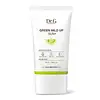What's inside
What's inside
 Key Ingredients
Key Ingredients

 Benefits
Benefits

 Concerns
Concerns

No concerns
 Ingredients Side-by-side
Ingredients Side-by-side

Water
Skin ConditioningDipropylene Glycol
HumectantSodium Acrylates Crosspolymer-2
AbsorbentGlycerin
HumectantBambusa Arundinacea Stem Powder
AbrasiveCellulose
Absorbent1,2-Hexanediol
Skin ConditioningRosa Centifolia Flower Water
Skin ConditioningButylene Glycol
HumectantPEG-40 Hydrogenated Castor Oil
EmulsifyingSodium PCA
HumectantVp/Methacrylamide/Vinyl Imidazole Copolymer
Alcohol Denat.
AntimicrobialCarbomer
Emulsion StabilisingSodium Hydroxide
BufferingCaprylyl Glycol
EmollientSalicylic Acid
MaskingButeth-3
SolventSodium Hyaluronate
HumectantSodium Benzotriazolyl Butylphenol Sulfonate
UV AbsorberEnantia Chlorantha Bark Extract
Skin ConditioningEthylhexylglycerin
Skin ConditioningParfum
MaskingCitric Acid
BufferingTributyl Citrate
SolventSodium Benzoate
MaskingLimonene
PerfumingPotassium Sorbate
PreservativeLinalool
PerfumingOleanolic Acid
Skin ConditioningWater, Dipropylene Glycol, Sodium Acrylates Crosspolymer-2, Glycerin, Bambusa Arundinacea Stem Powder, Cellulose, 1,2-Hexanediol, Rosa Centifolia Flower Water, Butylene Glycol, PEG-40 Hydrogenated Castor Oil, Sodium PCA, Vp/Methacrylamide/Vinyl Imidazole Copolymer, Alcohol Denat., Carbomer, Sodium Hydroxide, Caprylyl Glycol, Salicylic Acid, Buteth-3, Sodium Hyaluronate, Sodium Benzotriazolyl Butylphenol Sulfonate, Enantia Chlorantha Bark Extract, Ethylhexylglycerin, Parfum, Citric Acid, Tributyl Citrate, Sodium Benzoate, Limonene, Potassium Sorbate, Linalool, Oleanolic Acid
Water
Skin ConditioningZinc Oxide
Cosmetic ColorantPropanediol
SolventButyloctyl Salicylate
Skin ConditioningPropylheptyl Caprylate
EmollientCoco-Caprylate/Caprate
EmollientCyclohexasiloxane
EmollientCaprylyl Methicone
Skin ConditioningIsododecane
EmollientLauryl Polyglyceryl-3 Polydimethylsiloxyethyl Dimethicone
Skin ConditioningMethyl Trimethicone
Skin ConditioningMethyl Methacrylate Crosspolymer
Disteardimonium Hectorite
StabilisingMagnesium Sulfate
Triethoxycaprylylsilane
1,2-Hexanediol
Skin ConditioningPolyglyceryl-2 Dipolyhydroxystearate
Skin ConditioningPolymethylsilsesquioxane
Glyceryl Caprylate
EmollientCaprylyl Glycol
EmollientEthylhexylglycerin
Skin ConditioningSodium Hyaluronate
HumectantButylene Glycol
HumectantTocopherol
AntioxidantCentella Asiatica Extract
CleansingCaesalpinia Spinosa Fruit Extract
Skin ProtectingPinus Pinaster Bark Extract
AntioxidantKappaphycus Alvarezii Extract
Skin Conditioning7-Dehydrocholesterol
Emulsion StabilisingHouttuynia Cordata Extract
Skin ConditioningEctoin
Skin ConditioningBuddleja Officinalis Flower Extract
UV FilterLactobacillus Ferment
Skin ConditioningHydroxycinnamic Acid
Skin ConditioningRutin
AntioxidantWater, Zinc Oxide, Propanediol, Butyloctyl Salicylate, Propylheptyl Caprylate, Coco-Caprylate/Caprate, Cyclohexasiloxane, Caprylyl Methicone, Isododecane, Lauryl Polyglyceryl-3 Polydimethylsiloxyethyl Dimethicone, Methyl Trimethicone, Methyl Methacrylate Crosspolymer, Disteardimonium Hectorite, Magnesium Sulfate, Triethoxycaprylylsilane, 1,2-Hexanediol, Polyglyceryl-2 Dipolyhydroxystearate, Polymethylsilsesquioxane, Glyceryl Caprylate, Caprylyl Glycol, Ethylhexylglycerin, Sodium Hyaluronate, Butylene Glycol, Tocopherol, Centella Asiatica Extract, Caesalpinia Spinosa Fruit Extract, Pinus Pinaster Bark Extract, Kappaphycus Alvarezii Extract, 7-Dehydrocholesterol, Houttuynia Cordata Extract, Ectoin, Buddleja Officinalis Flower Extract, Lactobacillus Ferment, Hydroxycinnamic Acid, Rutin
 Reviews
Reviews

Ingredients Explained
These ingredients are found in both products.
Ingredients higher up in an ingredient list are typically present in a larger amount.
1,2-Hexanediol is a synthetic liquid and another multi-functional powerhouse.
It is a:
- Humectant, drawing moisture into the skin
- Emollient, helping to soften skin
- Solvent, dispersing and stabilizing formulas
- Preservative booster, enhancing the antimicrobial activity of other preservatives
Butylene Glycol (or BG) is used within cosmetic products for a few different reasons:
Overall, Butylene Glycol is a safe and well-rounded ingredient that works well with other ingredients.
Though this ingredient works well with most skin types, some people with sensitive skin may experience a reaction such as allergic rashes, closed comedones, or itchiness.
Learn more about Butylene GlycolCaprylyl Glycol is a humectant and emollient, meaning it attracts and preserves moisture.
It is a common ingredient in many products, especially those designed to hydrate skin. The primary benefits are retaining moisture, skin softening, and promoting a healthy skin barrier.
Though Caprylyl Glycol is an alcohol derived from fatty acids, it is not the kind that can dry out skin.
This ingredient is also used as a preservative to extend the life of products. It has slight antimicrobial properties.
Learn more about Caprylyl GlycolEthylhexylglycerin (we can't pronounce this either) is commonly used as a preservative and skin softener. It is derived from glyceryl.
You might see Ethylhexylglycerin often paired with other preservatives such as phenoxyethanol. Ethylhexylglycerin has been found to increase the effectiveness of these other preservatives.
Sodium Hyaluronate is hyaluronic acid's salt form. It is commonly derived from the sodium salt of hyaluronic acid.
Like hyaluronic acid, it is great at holding water and acts as a humectant. This makes it a great skin hydrating ingredient.
Sodium Hyaluronate is naturally occurring in our bodies and is mostly found in eye fluid and joints.
These are some other common types of Hyaluronic Acid:
Learn more about Sodium HyaluronateWater. It's the most common cosmetic ingredient of all. You'll usually see it at the top of ingredient lists, meaning that it makes up the largest part of the product.
So why is it so popular? Water most often acts as a solvent - this means that it helps dissolve other ingredients into the formulation.
You'll also recognize water as that liquid we all need to stay alive. If you see this, drink a glass of water. Stay hydrated!
Learn more about Water